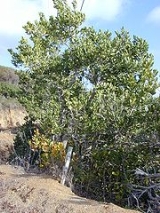
Noronhia emarginata
Encyclopedia
Noronhia emarginata is a species of Noronhia
native, and endemic to, Madagascar
.
It is an evergreen
shrub
or small tree growing to 3–15 m tall. It has smooth bark, stout terete branches and flattened terminal twigs. The leaves are opposite, elliptical or obovate, up to 16 cm long and 10 cm broad, with an entire margin and an emarginate (notched) apex. The flowers are small, pale whitish-yellow, fragrant, with a four-lobed corolla. The fruit
is a globose to turbinate
drupe
2–3 cm diameter, apiculate, bright yellow ripening dark purple, drying hard, dark brown, slightly rough with a single pyriform, dark russet seed, 10-12 mm long. The cotyledon
s are unequal.
in some areas, notably Hawaii
.
It is very tough in coastal and seaside locations, and has been successfully used in urban areas where air pollution, poor drainage, compacted soil and/or drought are common. It grows in part shade and in full sun. Soil tolerance is well-drained, acidic or alkaline clay, loam or sand. It has high drought tolerance, high aerosol salt tolerance and moderate soil salt tolerance.
Noronhia
Noronhia is a genus of 41 species of flowering plants in the family Oleaceae, all but one native to Madagascar, the remaining species native to the Comoros Islands north of Madagascar.The species are deciduous or evergreen trees....
native, and endemic to, Madagascar
Madagascar
The Republic of Madagascar is an island country located in the Indian Ocean off the southeastern coast of Africa...
.
It is an evergreen
Evergreen
In botany, an evergreen plant is a plant that has leaves in all seasons. This contrasts with deciduous plants, which completely lose their foliage during the winter or dry season.There are many different kinds of evergreen plants, both trees and shrubs...
shrub
Shrub
A shrub or bush is distinguished from a tree by its multiple stems and shorter height, usually under 5–6 m tall. A large number of plants may become either shrubs or trees, depending on the growing conditions they experience...
or small tree growing to 3–15 m tall. It has smooth bark, stout terete branches and flattened terminal twigs. The leaves are opposite, elliptical or obovate, up to 16 cm long and 10 cm broad, with an entire margin and an emarginate (notched) apex. The flowers are small, pale whitish-yellow, fragrant, with a four-lobed corolla. The fruit
Fruit
In broad terms, a fruit is a structure of a plant that contains its seeds.The term has different meanings dependent on context. In non-technical usage, such as food preparation, fruit normally means the fleshy seed-associated structures of certain plants that are sweet and edible in the raw state,...
is a globose to turbinate
Turbinate
In anatomy, a nasal concha is a long, narrow and curled bone shelf that protrudes into the breathing passage of the nose...
drupe
Drupe
In botany, a drupe is a fruit in which an outer fleshy part surrounds a shell of hardened endocarp with a seed inside. These fruits develop from a single carpel, and mostly from flowers with superior ovaries...
2–3 cm diameter, apiculate, bright yellow ripening dark purple, drying hard, dark brown, slightly rough with a single pyriform, dark russet seed, 10-12 mm long. The cotyledon
Cotyledon
A cotyledon , is a significant part of the embryo within the seed of a plant. Upon germination, the cotyledon may become the embryonic first leaves of a seedling. The number of cotyledons present is one characteristic used by botanists to classify the flowering plants...
s are unequal.
Cultivation and uses
It is cultivated as an ornamental tree in subtropical and tropical regions, and has become an invasive speciesInvasive species
"Invasive species", or invasive exotics, is a nomenclature term and categorization phrase used for flora and fauna, and for specific restoration-preservation processes in native habitats, with several definitions....
in some areas, notably Hawaii
Hawaii
Hawaii is the newest of the 50 U.S. states , and is the only U.S. state made up entirely of islands. It is the northernmost island group in Polynesia, occupying most of an archipelago in the central Pacific Ocean, southwest of the continental United States, southeast of Japan, and northeast of...
.
It is very tough in coastal and seaside locations, and has been successfully used in urban areas where air pollution, poor drainage, compacted soil and/or drought are common. It grows in part shade and in full sun. Soil tolerance is well-drained, acidic or alkaline clay, loam or sand. It has high drought tolerance, high aerosol salt tolerance and moderate soil salt tolerance.

